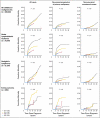Temporal trends in cause-specific late mortality among 5-year survivors of childhood cancer
- PMID: 20124180
- PMCID: PMC3102544
- DOI: 10.1200/JCO.2009.24.4608
Temporal trends in cause-specific late mortality among 5-year survivors of childhood cancer
Abstract
Purpose: Five-year survival rates for childhood cancer have improved over the past four decades. However, it is unknown whether changes in primary cancer therapy have improved rates of long-term (> 5 years from diagnosis) durable remissions and reduced treatment-related deaths. We investigated changes in patterns of late mortality over time and cause-specific attribution of late-mortality among 5-year survivors.
Patients and methods: Using data from the Surveillance, Epidemiology and End Results (SEER) population-based registry, we assessed all-cause and cause-specific (recurrence/progression of primary disease, external cause, and nonrecurrence/nonexternal cause) late mortality during four consecutive time periods from 1974 through 2000 among 26,643 5-year survivors of childhood cancer.
Results: All-cause late mortality improved during more recent eras, dropping from 7.1% (95% CI, 6.4% to 7.8%) among children diagnosed during 1974 to 1980 to 3.9% (95% CI, 3.3% to 4.4%) among children diagnosed during 1995 to 2000 (P < .001), largely because of reduced mortality from recurrence or progression. While there was no significant reduction in mortality attributable to other health conditions (including treatment-related health conditions), analysis controlling for demographic characteristics identified a trend toward reduced risk during more recent eras (P = .007). Disparity by race/ethnicity was identified, with higher mortality among non-Hispanic blacks than among non-Hispanic whites for all-cause and nonrecurrence/nonexternal -cause late mortality.
Conclusion: While overall patterns of mortality from other health conditions do not differ over time, adjustment for demographic characteristics provides evidence that risk of treatment-related mortality may be lower in more recent eras. Disparities in health care utilization among survivors should be explored.
Conflict of interest statement
Authors' disclosures of potential conflicts of interest and author contributions are found at the end of this article.
Figures



References
-
- Ries LAG, Melbert D, Krapcho M, et al. SEER cancer statistics review. 2005:1975–2004.
-
- Lawless SC, Verma P, Green DM, et al. Mortality experiences among 15+ year survivors of childhood and adolescent cancers. Pediatr Blood Cancer. 2007;48:333–338. - PubMed
-
- Hudson MM, Jones D, Boyett J, et al. Late mortality of long-term survivors of childhood cancer. J Clin Oncol. 1997;15:2205–2213. - PubMed
-
- Möller TR, Garwicz S, Barlow L, et al. Decreasing late mortality among five-year survivors of cancer in childhood and adolescence: A population-based study in the Nordic countries. J Clin Oncol. 2001;19:3173–3181. - PubMed
Publication types
MeSH terms
LinkOut - more resources
Full Text Sources
Miscellaneous

